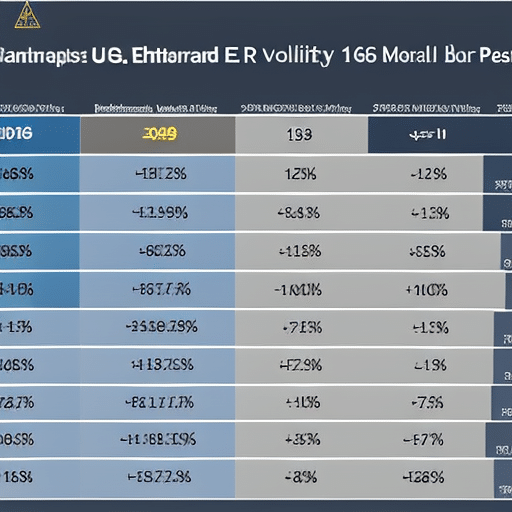Cryptocurrencies are a relatively new asset class that have been gaining traction in recent years. You may have heard of Bitcoin, the largest and most widely adopted cryptocurrency, but there are many others on the market. Volatility measures provide insights into the risk associated with investing in these digital assets. In this article, we’ll take a look at what volatility is, the different types of volatility, factors that affect it, and strategies for managing risk when investing in cryptocurrencies.
Table of Contents
ToggleOverview of Cryptocurrencies
You’ve probably heard of cryptocurrencies, but do you know what they are and how they work? A cryptocurrency is a form of digital currency that utilizes cryptography to secure transactions. It can be used as an investment asset to diversify one’s portfolio. It also has various legal implications depending on the country in which it is being used or traded. Cryptocurrencies are decentralized, meaning no single entity controls them. This allows for more efficient and secure transactions compared to traditional currencies, which are centrally managed by banks or governments. By incorporating portfolio diversification and understanding the legal implications associated with cryptocurrency use, investors can make better decisions when investing in these digital assets. With this knowledge in hand, we can now move on to understanding volatility measures for cryptocurrencies.
Definition of Volatility
Volatility is a measure of risk that reflects the magnitude of price movements, up or down, over a certain period of time. It can be measured in various ways, such as standard deviation, beta coefficient, and average true range. Knowing the volatility of an asset helps investors to determine how much risk they are willing to take when investing in it. Volatility can also be used to assess potential returns on investments by comparing different assets with different levels of risk associated with them.
Measurement of risk
Risk is a double-edged sword, and measuring it in cryptocurrency can be tricky business. When evaluating risk associated with cryptocurrency investments, several factors must be taken into account. These include:
- Regulatory compliance – the extent to which an asset or activity adheres to relevant legal regulations
- Liquidity risk – the risk of not being able to buy or sell an asset quickly enough at a reasonable price
- Credit/counterparty risk – the potential for loss due to a counterparty’s failure to fulfill its obligations
Each of these factors involves certain risks that require close monitoring by investors. To ensure that their investments are safe and secure, investors should stay informed about any changes in regulatory laws as well as market trends. By doing so, they can better assess the potential risks posed by different cryptocurrencies and make more informed decisions when investing. With this knowledge of risk in hand, investors can then turn to analyze price movements over time.
Price movements
Understanding price movements is essential to successful cryptocurrency investing, so you’ll want to keep a close eye on trends. Price movements can be affected by various external factors such as economic news, geopolitical events and investor psychology. Risk diversification is key to mitigating the effects of volatility and reducing downside risk in your portfolio. Investor psychology also plays an important role in influencing prices; when market sentiment shifts from positive to negative or vice versa, it may lead to significant price swings. Therefore, monitoring these factors can help investors spot potential entry and exit points for their investments. By keeping a watchful eye on price movements and other external factors, investors can adjust their strategies accordingly and reduce the risks associated with volatility. Having this knowledge gives them the confidence that they need to make informed decisions about their cryptocurrency investments and ensure maximum returns over time. With this insight into price movements in mind, it’s time to move onto exploring different types of volatility.
Types of Volatility
Volatility in cryptocurrencies can be divided into three distinct, yet interconnected, types: Historical Volatility, Implied Volatility and Realized Volatility. Historical volatility measures the price movements of a security over a certain period of time that has already passed. Implied volatility is derived from the options market and provides an estimate of what traders expect volatility to be going forward. Finally, realized volatility is the measure of how much the price actually moved during a given period of time. All three types are important to consider when trying to gauge potential risk associated with cryptocurrency investments.
Historical Volatility
Charting historical volatility can be like walking a tightrope; with one wrong move the whole thing can come crashing down. By analyzing trends in past performances, investors and analysts are able to gain a better understanding of future price movements in cryptocurrencies. This helps them develop effective hedging strategies and predict future volatility more accurately.
Using mathematical models such as GARCH or ARIMA, it is possible to forecast the degree of expected volatility over a given period of time with greater accuracy than other methods. These models also offer insight into potential opportunities for profit through trading during periods of high or low volatility, which makes them an essential tool for any investor interested in cryptocurrency markets. With this information, investors can make informed decisions about their investments and better manage their risk. As such, charting historical volatility provides invaluable insight into the crypto market that cannot be obtained from any other source. Now moving on, let’s take a look at implied volatility – another important measure when it comes to risk assessment in cryptocurrency markets.
Implied Volatility
Implied volatility is a way of assessing future market risk by looking at the prices of options, providing investors with an idea of how much movement to expect in the coming months. This measure is used by investors to help them make decisions about when and how to invest in volatile assets such as cryptocurrencies. Here are some key points about implied volatility:
- It is derived from option pricing models that take into account the current market price of an asset;
- It can be affected by liquidity issues and blockchain technology, which makes it different from other traditional markets;
- Implied volatility does not always accurately reflect true or future movements in an asset’s price;
- It is typically more accurate for longer-term investments than short-term investments. By understanding implied volatility, investors can better gauge future risks associated with cryptocurrency investments and plan accordingly. Moving forward, we will discuss realized volatility – another important measure for assessing risk in the cryptocurrency market.
Realized Volatility
Realized volatility measures the actual price movements of an asset over a given period, giving you a better understanding of how volatile it has been in recent days. For example, if Bitcoin’s realized volatility has been increasing significantly over the past few weeks, it may be wise to reevaluate your strategy as opposed to relying solely on implied volatility estimates. This is especially important because market manipulation and lack of regulatory oversight can have an outsized effect on realized volatilities. Therefore, it is essential to consider both implied and realized volatilities when making investment decisions related to cryptocurrencies in order to make informed decisions about the future direction of prices. With this knowledge firmly in hand, transitioning into the subsequent section about factors that affect volatility should be easier than ever.
Factors that Affect Volatility
Understanding the factors that affect volatility of cryptocurrencies is essential for trading success! There are many different factors that can cause the price of a cryptocurrency to fluctuate. These include:
- Market sentiment – public opinion and investor sentiment play an important role in determining how volatile a cryptocurrency will be. Positive news or events can lead to increased demand, which tends to drive prices up, while negative news or events tend to have the opposite effect.
- Regulation changes – government regulations often have a direct impact on the markets and can have an effect on cryptocurrencies. Changes in regulations can create uncertainty and cause prices to move in unpredictable directions.
- Supply and demand – when there is higher demand for a particular crypto asset compared with its supply, it usually leads to increased volatility as investors scramble to take advantage of any potential gains. On the other hand, if there is low demand but high supply then prices may decline due to lack of interest from buyers in the market.
- Technical analysis – technical analysis uses tools such as charts, indicators, oscillators etc., which helps traders identify trends and make predictions about future price movements based on past data points which could also help increase or decrease volatility levels in certain cases depending on market conditions at any given time.
Having a strong understanding of these factors can go a long way towards helping traders make informed decisions when investing in cryptocurrencies so they can minimize losses due their investments being exposed too much risk associated with extreme levels of volatility experienced by digital assets from time-to-time.. Knowing how these various elements interact with each other can provide valuable insight into predicting future price movements and preparing for potential opportunities ahead when it comes to trading cryptos successfully!
Uses of Volatility
The use of volatility in trading can be beneficial as it provides an opportunity to capitalize on market movements and take advantage of potential gains. By understanding the dynamics of market volatility, traders can develop effective trading strategies that help them capitalize on short-term price fluctuations. Volatility is also used to identify trends in the markets, which can indicate whether prices are likely to rise or fall in the near future. This knowledge allows traders to adjust their trading strategies accordingly and increase their chances of making profits.
The use of volatility measures also helps investors determine the risk associated with a particular investment so they can make informed decisions. By analyzing historical data, investors can understand how much movement they should expect from a certain cryptocurrency over time and create appropriate portfolios that minimize risk while still providing potential returns. With this information, investors can make smarter decisions about when to buy and sell cryptocurrencies based on market conditions, helping them maximize their profits while minimizing risks. With all these uses combined, volatility measures provide invaluable insight into the crypto markets that can help traders and investors alike make more informed decisions.
Volatility Indexes
You can gain valuable insight into cryptocurrency markets by tracking volatility indexes. Volatility indexes are tools that measure the price fluctuations of a given asset over time, such as cryptocurrencies. They take into account the open, close, high and low prices for each day in order to calculate a rolling average that is used to predict future trends. Popular volatility indexes include the CryptoCompare Volatility Index (CCVI), which tracks 10 major cryptocurrencies; and the Bitcoin Volatility Index (BVIX), which measures daily changes in Bitcoin’s price.
Volatility indexes can also be used in combination with other trading strategies such as cryptocurrency derivatives or algorithmic trading to create more accurate predictions on price movements. By monitoring these indices, traders can identify opportunities to buy or sell based on their risk tolerance levels and market conditions. With this information, they can develop better strategies for investing in volatile digital assets like cryptocurrencies. Consequently, understanding how volatility indexes work is essential for any serious crypto trader looking to maximize profits while minimizing risk. To learn more about how to use these indexes effectively, next we’ll explore different types of volatility strategies.
Volatility Strategies
Gearing up to trade in volatile digital assets like cryptocurrencies? Then you’ll want to make sure you’ve got the right strategies for managing risk and maximizing profits. When it comes to volatility strategies, one of the most common tactics employed is volatility hedging. Volatility hedging is a strategy used by investors who are looking to minimize their exposure to market price fluctuations by offsetting potential losses with gains from other investments. This can be done through derivatives such as options or futures contracts, as well as through leveraged ETFs and inverse ETFs. Additionally, traders may also consider taking into account market sentiment when determining their volatility strategy; understanding the current state of investor opinion can help inform decisions about entering and exiting trades. With these tactics in mind, investors should be better equipped to navigate volatile markets and manage risk effectively before transitioning into discussing the risks of investing in cryptocurrencies.
Risks of Investing in Cryptocurrencies
Investing in cryptocurrencies comes with many risks. Fraud is one of the biggest concerns, as there are plenty of malicious actors out there looking to take advantage of unsuspecting investors. There’s also a risk associated with the high volatility that comes with investing in digital currencies, making it difficult for investors to accurately predict market trends and make profitable trades. Finally, cybersecurity threats can present another layer of risk; hackers could potentially steal funds from users or interfere with trading platforms.
Risk of Fraud
The risk of fraud in cryptocurrencies is alarming, leaving you feeling vulnerable and unprotected. Exchange fraud and wallet theft are two of the most common occurrences, with even the most secure exchanges being susceptible to hacker attacks, leading to stolen funds and personal data. The lack of an overarching authority makes it difficult to recover lost money due to fraudulent activities. Additionally, scammers have been known to take advantage of newcomers looking for investments or advice on the crypto market by providing false guidance or information. As such, it is important that investors be aware of these risks when considering investing in cryptocurrencies.
In order to protect yourself from potential losses due to fraud, it is essential that you take extra caution when exchanging or storing your cryptocurrency. Always research a platform before investing in it; check for reviews from users who have already used the service as well as any security features they offer. It is also important that you keep your passwords safe and use two-factor authentication whenever possible so that only you can access your account credentials. By taking these steps, you can help ensure your safety and reduce the likelihood of falling victim to fraudulent activities associated with cryptocurrency trading. To further minimize this risk, however, one must also consider volatility risk associated with crypto trading which will be discussed next.
Volatility Risk
Due to the ever-changing nature of cryptocurrency markets, investors must be aware of the potential for extreme volatility which can lead to significant losses. Volatility risk is an important factor that must be taken into account when investing in cryptocurrencies as it affects both short and long-term economic impacts. This risk is exacerbated by the lack of a regulatory environment that could provide stability and predictability in such a rapidly changing market. Furthermore, sudden spikes or drops in prices can have drastic effects on portfolios and require careful monitoring to ensure that risks are managed properly. As such, understanding how volatility works and its implications is essential for all investors looking to make informed decisions about their investments.
The potential for volatility also has further implications beyond just financial loss; it may also affect broader economic conditions if left unchecked. With markets lacking proper regulation, wild swings in prices can cause panic among investors which could lead to widespread sell-offs and devaluation of assets. Additionally, large fluctuations may create incentives for traders to take advantage of price movements by engaging in activities like market manipulation or insider trading. As such, investors need to be aware of these risks when entering the cryptocurrency markets so they can make more informed decisions about their investments. To mitigate this risk, it is important for regulators to establish strong oversight measures while developing better frameworks for monitoring market activity. With these precautions in place, investors will have greater confidence when investing in cryptocurrencies as they will know their investments are adequately protected from potential volatility risks. Transitioning into cybersecurity risk requires assessing the threats posed by hackers who seek personal information or access funds through malicious means and outlines strategies for minimizing those risks
Cybersecurity Risk
Protecting yourself from the dangers of cyberattacks is essential when investing in cryptocurrencies, so you can rest assured that your funds and personal data are secure. Cybersecurity risks associated with crypto investments include:
- Cyber bullying – malicious actors sending threatening emails to investors or attempting to extort them out of their funds
- Malware attacks – hackers infecting computers with malicious software designed to steal user data
- Phishing scams – criminals posing as legitimate service providers in order to trick users into revealing their credentials
Being aware of these threats and taking the necessary steps to protect yourself against them is key for navigating cryptocurrency markets safely. To ensure a safe and secure trading experience, it’s important to take proactive measures like using strong passwords and two-factor authentication, keeping up-to-date on security vulnerabilities, running regular scans for malware infections, and avoiding phishing links or emails. With these precautions taken, you’ll be better equipped to manage any potential cybersecurity threats while investing in cryptocurrencies. By staying informed about cyber security risk management strategies, you can confidently move forward on your investment journey without fear of being victimized by online attackers.
Strategies for Managing Risk
You’d better take steps to manage cryptocurrency risk, or else you’ll be sorry. Investing in cryptocurrencies comes with its own unique set of risks and rewards. One way to mitigate the risk of volatile price fluctuations is through value investing. Value investing is a strategy that seeks to identify undervalued assets and purchase them at a lower cost while waiting for their prices to increase over time. This approach helps investors maximize returns while minimizing opportunity costs. Another way to manage risk is by diversifying investments across different sectors of the crypto market, which can help reduce volatility and spread out any losses in case one particular sector takes a hit. Additionally, it’s important to keep up with the latest news developments related to cryptocurrencies, as these have been known to affect prices significantly. Keeping an eye on relevant news updates can help you stay informed and make smarter investment decisions.






















